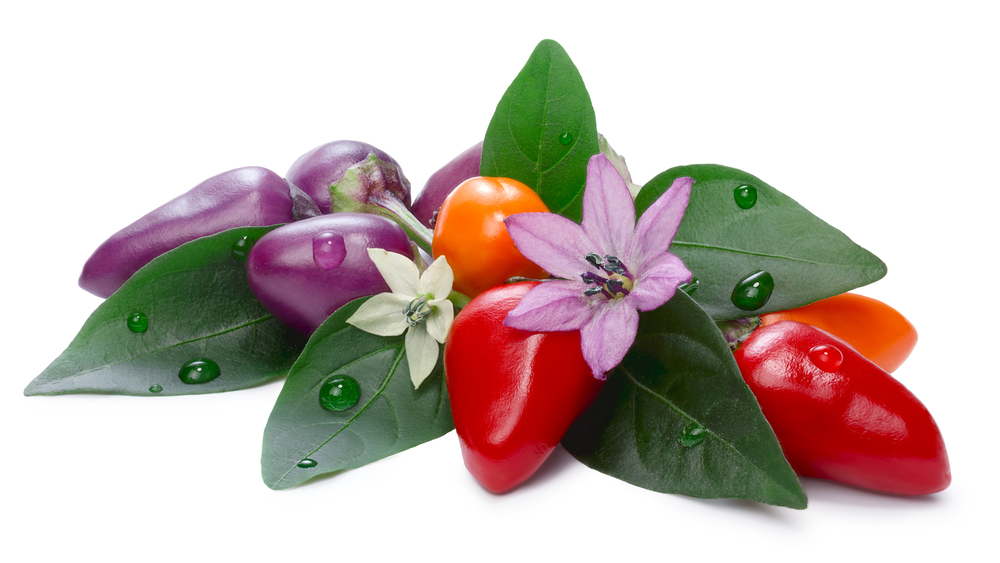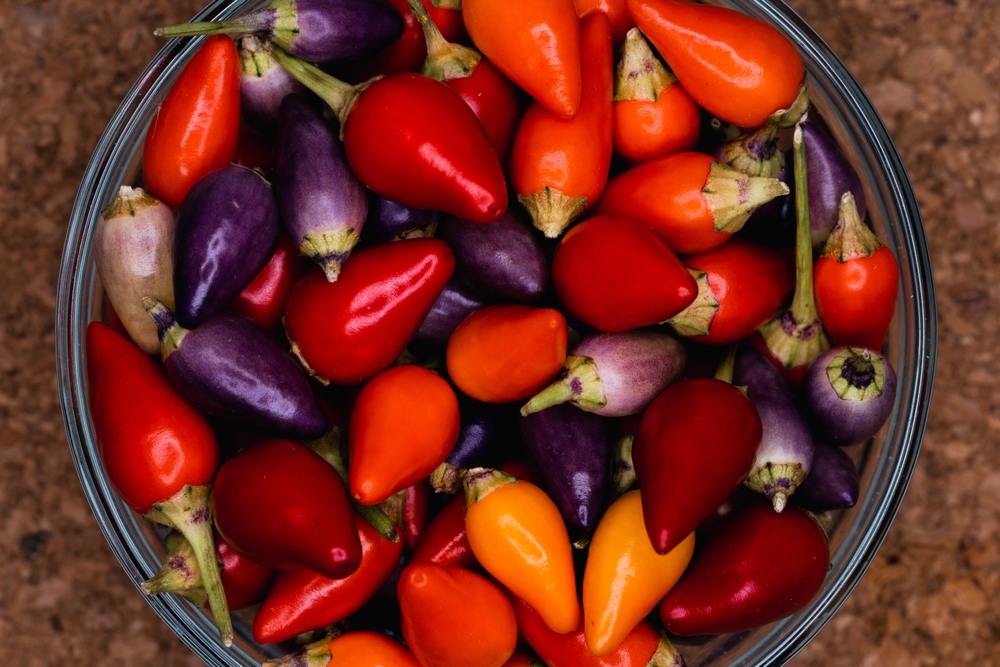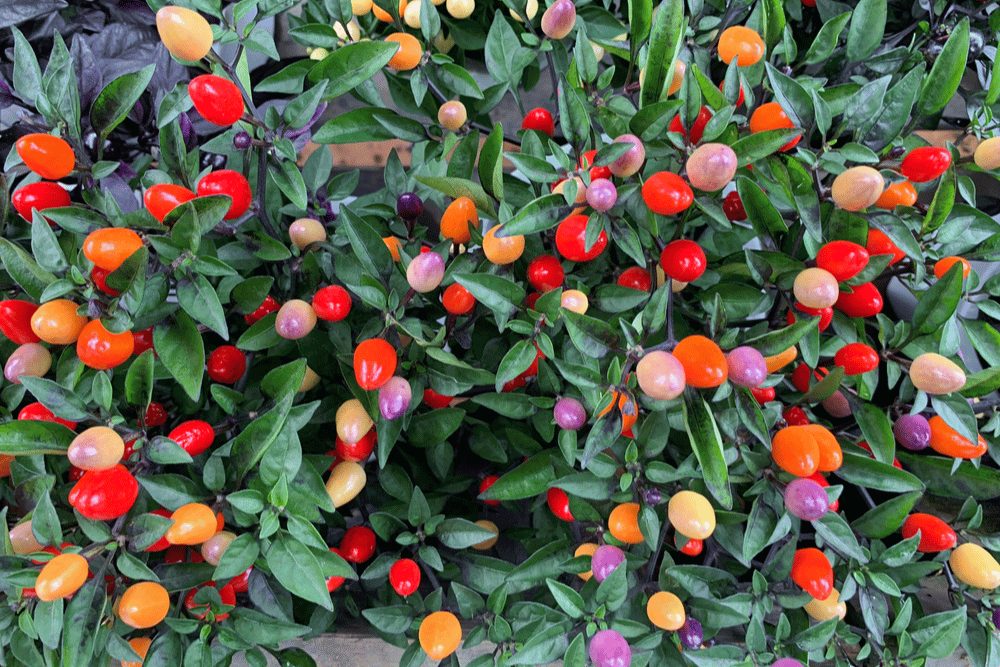A Bolivian rainbow pepper is a colorful ornamental pepper plant with upright clusters of multi-colored fruits resembling Christmas tree lights. Aside from beautifying your home or garden, Bolivian rainbows give your bland dishes a nice kick of heat and a stunning hue.
What Are Bolivian Rainbow Peppers?
Bolivian rainbow peppers are moderate-hot heirloom peppers native to Bolivia. They are members of the capsicum annuum species, along with other unique ornamental peppers like black pearl peppers.
The Bolivians have been growing these rainbow-colored peppers for centuries due to their stunning beauty, excellent landscaping, moderate spiciness, and exceptional ability to give dishes magical popping colors.
Bolivian rainbow pepper plants are small-sized and bushy with open-spreading branches that create a beautiful cascade of multi-colored pods. Since different pods bloom and ripen at various stages, you’ll always have a rainbow of colors in your garden.
Origin
These rainbow peppers originate from a landlocked central South-American country called Bolivia.
Bolivians grow the peppers primarily for landscaping. The colorful peppers’ manageable heat and deep, vibrant hues make them an integral part of authentic Bolivian dishes.
Color
Bolivian rainbow peppers mimic a rainbow. The pods change color depending on their ripening stage to create a stunning display of colors.
Bolivian rainbow peppers start with a cream color, before turning into a brilliant purple, to yellow, then orange, and finally deep red.
Its attractive star-shaped flowers are purple, while its leaves have a unique green hue, making it an attractive bush even when not fruiting.
Size
These color-rich pepper pods are tiny. They are .75-1 inches long and .5-.75 inches wide. Bolivian rainbows grow upright, facing the sun, on a 2-3 ft. high pepper plant.
Texture
Bolivian rainbow peppers’ skin is smooth and soft-textured.
Appearance
The rainbow peppers have an attractive appearance. They look like dozens of multi-colored Christmas lights.
Bolivian rainbow peppers’ blend of cool purple, yellow and red colors is excellent for livening up any patio, garden, or bed.
Shape
The peppers have a conical shape resembling tiny water drops.

What Do Bolivian Rainbow Peppers Taste Like?
Bolivian rainbow peppers have a less-than-outstanding flavor profile. They offer a neutral, crispy, grassy, peppery taste with a slight tanginess.
They taste like a bell pepper, with serrano pepper’s heat level.
Are Bolivian Rainbow Peppers Edible?
Bolivian rainbow peppers are exceptional for ornamental purposes but not their flavor. Nevertheless, the peppers are edible!
How Hot Are Bolivian Rainbow Peppers?
The beauties from Bolivia are classified as medium-hot peppers. With a range of 10,000-30,000 SHUs on the Scoville scale, Bolivian rainbow peppers are 5-10 times spicier than a typical jalapeno.
The tabasco pepper (30,000-50,000 Scoville heat units ) and cayenne peppers have the same heat level that’s slightly higher but closer to Bolivian rainbow peppers.
Serrano peppers (10,000-25,000 SHUs) are similar in heat to Bolivians, while the mighty habanero ranks 12 times hotter.
How To Use Bolivian Rainbow Pepper
Bolivian rainbow peppers have various uses, including:
- In fresh salads –Toss thinly sliced Bolivian rainbow peppers in fresh fruit and vegetable salads for colorful, medium-spiced heat.
- Salsas – Fresh salsas look beautiful with these rainbow peppers.
- Hot sauces – Bolivian rainbow peppers possess a surprising heat kick that is great for hot sauces, especially when combined with other peppers with varying flavor profiles.
- Pickling – Pickled Bolivian rainbows make beautiful and tangy garnishes for any dish.
- Landscaping – Use the colorful peppers and flowers to decorate your garden, flower bed, hedge, or home. If you don’t want to eat the peppers, toss them into your compost bin!
Where To Buy Bolivian Rainbow Peppers
Since Bolivian rainbow peppers are commonly grown for landscaping, you may be lucky to get seeds or seedlings from a gardening center near you.
It’s rare to find these stunning peppers outside Bolivia. If you live outside this locality, buying Bolivian rainbow pepper seeds and planting them is your best bet. Their non-GMO seeds and pepper plants are available from online stores, including Amazon.
Can You Grow Bolivian Rainbow Peppers?
Bolivian rainbow peppers are easy to grow and maintain since they are drought-resistant and a natural insect repellent.

When planting these hot pepper seeds, start indoors eight weeks before the last spring frost. These ornamental pepper seeds sprout within 7-21 days with full sun and moisture. Bolivian rainbow peppers take 110-155 days to mature into a bushy 2-3 foot plant.
Transplant once the pepper plants develop 5-6 true leaves. You may gradually transition into a container and later to rich soils outdoors. Use compost sparingly and ensure your plants have enough sunlight and proper watering so you have beautiful rainbow peppers throughout the growing season.
What Are The Health Benefits Of Eating Bolivian Rainbow Peppers?
Like other c. annuum pepper varieties, Bolivian rainbow peppers are nutrient-rich and medicinal. They have capsaicin, a compound with numerous benefits.
Some of the health benefits you get from eating these peppers include:
- Relieving pain – Bolivian rainbow peppers are rich in capsaicin, reducing the substance (P) responsible for transmitting nerve pain. Capsaicin is an active ingredient in arthritic pain medication.
- Promoting cardiovascular health – Eating capsaicin-rich rainbow peppers lowers harmful blood cholesterol and blood pressure while unclogging arteries. According to research, the compound prevents heart attacks and strokes.
- Curbing stomach ulcers – Capsaicin triggers the healing of stomach ulcers by stimulating the stomach’s protective mechanism against ulcers.
- Weight loss– Rainbow pepper’s capsaicin reduces appetite/energy intake and promotes fat burning to enhance weight loss.
- Fighting infections – like other peppers, Bolivian rainbows have anti-inflammatory and antibacterial properties effective for fighting infections.

